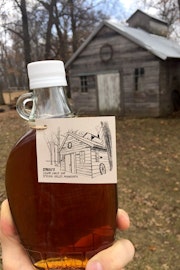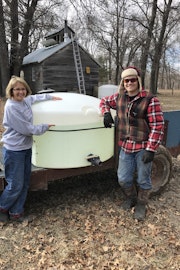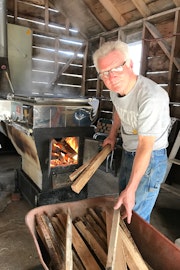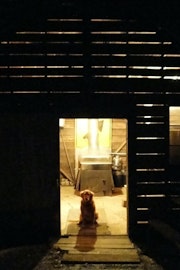


What do asparagus, brussels sprout, waffles, granola, and hot cereal have in common? They’re excellent means for transporting Sugar Shack pure maple syrup from the plate to your mouth. Our family has been making syrup for 29 years and I bring a couple of gallons up to Voyageur each spring. Work camp volunteers in mid-May especially enjoy the sweet, rich tree juice at breakfast before John pulls out the daily chores list.
Trees are tapped with metal spouts as Old Man Winter breaks in March, marked by average lows in the 20s and highs in the upper 30s. Buckets or bags are hung on the spouts to collect the sap as it flows up and down the tree during the daily freeze/thaw cycle. Up to four taps can be used per tree, depending on its size. On a good day, each tap can produce over four gallons of sap. We usually put out 120 taps and our best daily run this year produced 330 gallons of sap which made about eight gallons of syrup. It takes roughly 40 gallons of sap to make one gallon of syrup.
We pour the bags of sap into buckets, then dump it into a 350-gallon bulk tank on a modified trailer. The tractor dances and churns through the mud on its way home with diluted liquid gold. A sump pump transfers the sap into our stainless steel bulk tank in the sugar shack. We open up the cupola and valves, fire up the wood stove evaporator, and within 10 minutes the sap is boiling. Our old system of two flat stainless steel pans could boil off 10 gallons of sap per hour. Our new evaporator uses floats, channels, and a convoluted bottom to increase the pan’s surface area, boiling 30 gallons of water out of the sap per hour!



The sap weaves through the evaporator’s channels, as gravity and heat concentrate the sugar so that the final pan section contains the thickest mixture. After a few hours, a temperature gauge in the final section tells us the sap is 6 degrees above the boiling point of water– 1 degree away from pure maple syrup. Close enough for now, as we leave the fine-tuning to our propane finishing pan. We open the valve and filter the “almost” syrup into a stainless steel pot and store it until we’re ready to bottle. We must be careful with concentrated nectar. If you spill a cup of syrup, it’s like spilling two gallons of sap!
We collect the sap every day or two. Once we have several gallons of almost syrup, we dump about three gallons at a time into the finishing pan and heat it to seven degrees above the boiling point of water. We confirm the sugar content with a hydrometer, filter it one last time, and bottle it, maintaining the temperature above 180 degrees to sterilize the bottles and seal the caps.
In 2023, we made 23 gallons of syrup with 120 taps in only 10 days. Usually, it takes two or three weeks to collect that much. We sell some and give away more. The delicious tree juice is nature’s finest sweetener. Stop by Camp this summer and see for yourself!



